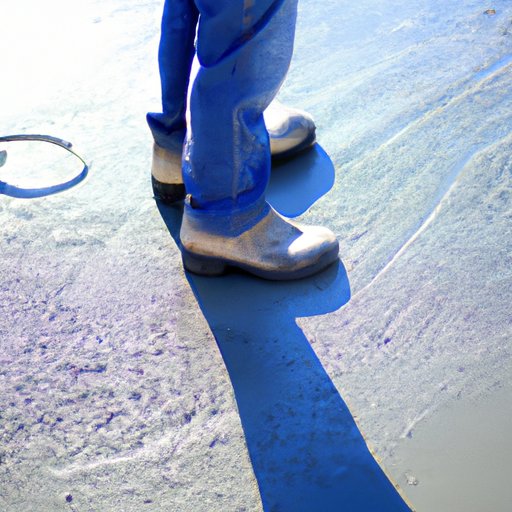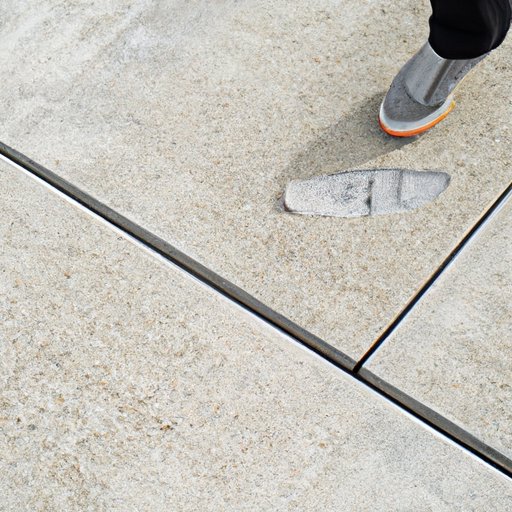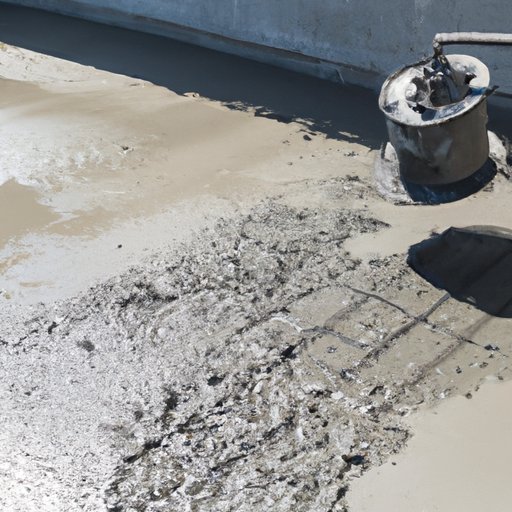Introduction
Concrete is a versatile material used in a variety of applications, from foundations and driveways to sidewalks and patios. But, one thing all concrete projects have in common is the need to give the material adequate time to dry and cure before it can be walked on. Knowing how long before you can walk on concrete is essential for ensuring your project lasts for years to come.
How Long Does It Take for Concrete to Set and Be Safe to Walk on?
The amount of time it takes for concrete to set and be safe to walk on depends on several factors, including the type of concrete mix used, the ambient air and surface temperatures, and the relative humidity. In general, concrete takes about 24-48 hours to dry and become ready for light foot traffic, and up to 7 days for heavy foot traffic or vehicle traffic.
Factors That Affect Curing Time
The type of concrete mix used will affect the curing time. For instance, fast-setting concrete mixes may be ready for light foot traffic within 24 hours, while slower-setting mixes may take up to 48 hours. The ambient air and surface temperatures also play a role in determining how quickly the concrete will set. Warmer temperatures speed up the curing process, while cooler temperatures slow it down. Finally, relative humidity impacts the rate of evaporation and thus affects the drying time. High relative humidity slows the drying process, while low relative humidity speeds it up.
Average Curing Times for Different Types of Concrete
As a general rule, concrete takes 24-48 hours to dry and be ready for light foot traffic, and up to 7 days for heavy foot traffic or vehicle traffic. This timeline is based on standard concrete mixes with a slump of 4-5 inches and a water-cement ratio of 0.45-0.50. Keep in mind that these are just guidelines and actual curing times may vary depending on the type of concrete mix used and the environmental conditions.
The Role of Weather in Drying Concrete
Weather plays an important role in the drying and curing process of concrete. Warm temperatures speed up the curing process, while cold temperatures slow it down. Relative humidity is also a factor, as high humidity slows the rate of evaporation and thus affects the drying time. It’s important to keep an eye on the weather forecast when planning a concrete project, as extreme temperatures and high humidity can significantly increase the drying time.

An Expert Guide to Curing and Walking on Freshly Laid Concrete
Proper curing is essential for ensuring the longevity of any concrete project. Here are some tips for a successful curing process:
How to Prepare the Substrate
Before pouring concrete, it’s important to prepare the substrate by removing any debris and smoothing the surface. This will help ensure the concrete sets evenly and reduces the risk of cracking or other issues.
Tips for Applying a Cure and Seal
Applying a cure and seal product after the concrete has been poured is recommended for most residential applications. This step helps protect the concrete from stains and wear. Make sure to read and follow the manufacturer’s instructions carefully when applying a cure and seal product.
Techniques for Ensuring Proper Curing
Once the concrete has been poured and leveled, it’s important to ensure proper curing by keeping the concrete moist during the first few days. This can be done by covering the concrete with a plastic sheet or damp burlap. Additionally, make sure to keep the concrete out of direct sunlight and away from strong winds during this time.
What to Expect When You’re Waiting for Concrete to Dry
Once the concrete has been poured and leveled, it’s important to give it time to dry and cure properly. Here are some signs that the concrete is drying:
- The surface of the concrete will become harder and more difficult to scratch.
- The color of the concrete will become lighter as the moisture evaporates.
- The concrete will become less sticky and less likely to leave footprints.
The effects of temperature and humidity on drying times can vary greatly. Hot and dry conditions will speed up the drying process, while cool and humid conditions will slow it down. If the weather is particularly hot or dry, it’s a good idea to mist the concrete with water every few hours to keep it moist and prevent cracking.
How to Tell When It’s Safe to Walk on Newly Laid Concrete
Once the concrete has been given enough time to dry and cure, it should be safe to walk on. To test the surface before walking on it, try pressing a coin into the concrete. If the coin leaves a visible impression, then the concrete is still too soft and needs more time to dry. If the coin doesn’t leave an impression, then the concrete is likely safe to walk on.
It’s also a good idea to check the curing process by testing the surface temperature of the concrete. If the temperature is higher than 80°F (27°C), then the concrete is still in the curing process and is not ready to be walked on.
A Comprehensive Look at the Curing Process of Concrete
Understanding the curing process of concrete is essential for knowing how long before you can walk on it. There are four stages of concrete curing: evaporation, hydration, hardening, and finishing. During the evaporation stage, excess moisture on the surface of the concrete is evaporated into the air. The hydration stage involves the chemical reaction between the cement and water, which forms a hardened paste. During the hardening stage, the paste begins to harden and gain strength. Finally, during the finishing stage, the concrete is smoothed and polished for a finished look.
Moisture loss is an important part of the curing process. As the concrete dries, the paste begins to harden and gain strength. Too much moisture loss too quickly can cause the concrete to crack due to shrinkage, so it’s important to control the rate of evaporation. This can be done by keeping the concrete covered and wet for the first few days after it has been poured.
The temperature and humidity of the environment also play an important role in the curing process. High temperatures and low humidity speeds up the curing process, while low temperatures and high humidity slows it down. Keeping the concrete in a controlled environment with temperatures between 65-80°F (18-27°C) and relative humidity between 40-60% is ideal for optimal curing.

The Science Behind Walking on Fresh Concrete: What You Need to Know
Knowing how long before you can walk on concrete is just the beginning. It’s also important to understand the science behind walking on fresh concrete. When pressure is applied to freshly laid concrete, it causes the paste to compress and release air bubbles, which weakens the concrete. If the concrete is walked on too soon, it can cause the concrete to crack and weaken the overall structure.
There are potential hazards associated with walking on fresh concrete, such as slips and falls. The surface of the concrete can be slippery and uneven, making it difficult to walk on without slipping. Additionally, walking on fresh concrete can cause indentations in the surface, which can weaken the structure over time.
Conclusion
In conclusion, it’s important to know how long before you can walk on concrete. Concrete generally takes 24-48 hours to dry and be ready for light foot traffic, and up to 7 days for heavy foot traffic or vehicle traffic. Factors such as the type of concrete mix used, the ambient air and surface temperatures, and the relative humidity can all affect the drying time. Additionally, it’s important to understand the science behind walking on fresh concrete, as pressure can cause the paste to compress and release air bubbles, weakening the structure.
Remember, it’s always best practice to wait for the concrete to set fully before walking on it. Doing so will help ensure your project lasts for years to come.
(Note: Is this article not meeting your expectations? Do you have knowledge or insights to share? Unlock new opportunities and expand your reach by joining our authors team. Click Registration to join us and share your expertise with our readers.)
